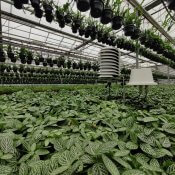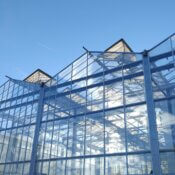How to measure soil moisture for optimal irrigation?
Data-based horticulture is becoming increasingly important. Accessible, granular data enables growers to make better decisions and quick, effective responses to changing circumstances. Wireless sensors provide that data in addition to your climate system. For example, follow the moisture values in substrate slabs, potting soil or arable soil and use this data to optimize irrigation. Via the 30MHz platform you will receive warnings as soon as the humidity levels are too low or too high.
Measuring soil moisture
30MHz connected the moisture sensors from Metergroup to measure the state of the substrate. We have connected multiple sensors:
- Substrate moisture sensor (Teros 12) monitors VWC, EC and temperature
- Arable Soil Moisture sensor (Teros 10) monitors VWC and temperature
- Potted Soil Moisture sensor (EC5) monitors VWC
VWC (Volumetric Water Content)
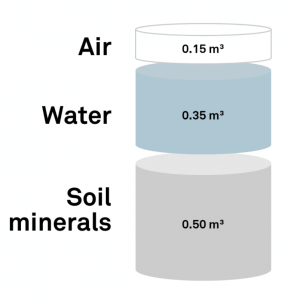 Volumetric Water Content (VWC) is the volume of water divided by the volume of soil. So, the VWC is the percentage of water in a soil sample. For instance, if a volume of soil was made up of the following constituents: 50% soil minerals, 35% water, and 15% air, that soil would have a 35% volumetric water content.
Volumetric Water Content (VWC) is the volume of water divided by the volume of soil. So, the VWC is the percentage of water in a soil sample. For instance, if a volume of soil was made up of the following constituents: 50% soil minerals, 35% water, and 15% air, that soil would have a 35% volumetric water content.
EC (Electrical Conductivity)
In the platform, you will see two electrical conductivity parameters, ECb and ECw. The Substrate moisture sensor measures the ECb (Bulk EC) as a raw value. ECb is the bulk soil (soil, water, and air). ECw (Pore EC) is the electrical conductivity of the water in the soil pores. The agriculture industry standard, or what is usually meant by EC, is pore water EC, which we abbreviate in the platform to ECw (water).
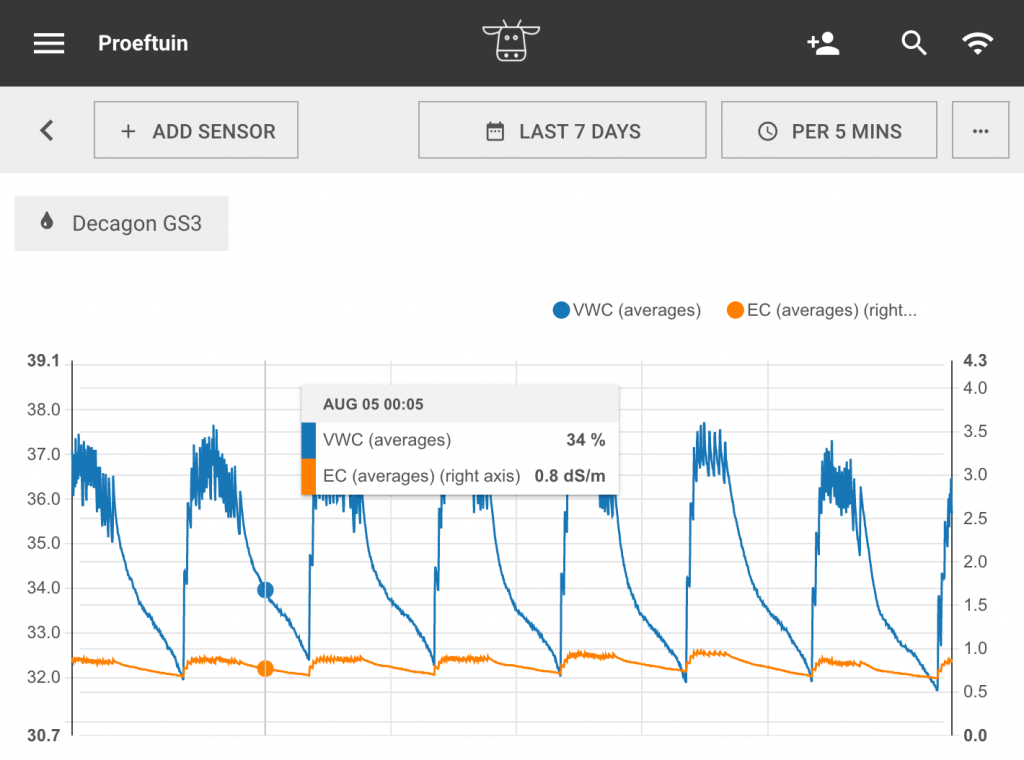
ECw is a calculated parameter. To measure the ECw, tiny sensors would have to be inserted into microscopic water-filled pores. Obviously, it’s not possible to measure the EC of water on that scale. In fact, the only way to measure pore water EC is by extracting a soil water sample and measuring the EC of that sample. We use equations to calculate the pore water EC (ECw), this is done by taking the VWC & ECb values.

You will be notified in the platform by an error icon in the sensors list when the VWC is below 25%.
If the VWC is below 25% then the ECw reading is not accurate, so we have chosen not to display this figure on your charts. So if you find breaks in your ECw charts, this is because of the low VWC reading.
How does the sensor measure?
The Substrate Moisture sensors have probes/metal needles that form an electromagnetic field (see image below). These probes are metal electrodes and measure the charge-storing capacity of the material in between the probes. This is called capacitance technology. Metergroup is specialized in this way of measuring. They have gathered a lot of interesting information about this technology.
Substrate moisture sensor (Teros 12)
The sensor is designed for measuring moisture in substrates. It also monitors electrical conductivity and temperature of the substrate. A lot of our customers use this sensor as their rockwool moisture meter, but it can also be used for other substrate material.
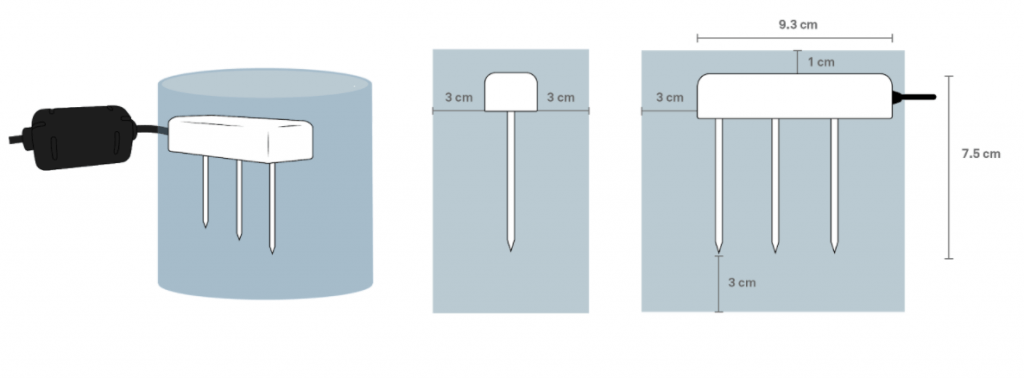
Arable Soil Moisture sensor (Teros 10)
Using real-time data from soil sensors, farmers can adjust and tailor a granular approach to irrigation and nutrient delivery. Custom alerts can provide insights on which crops are in need of irrigation, and which are in need of drainage to prevent the damaging effects of overwatering including standing water compromising root development, overaccumulation of salts, root rot, fungus and mildew.
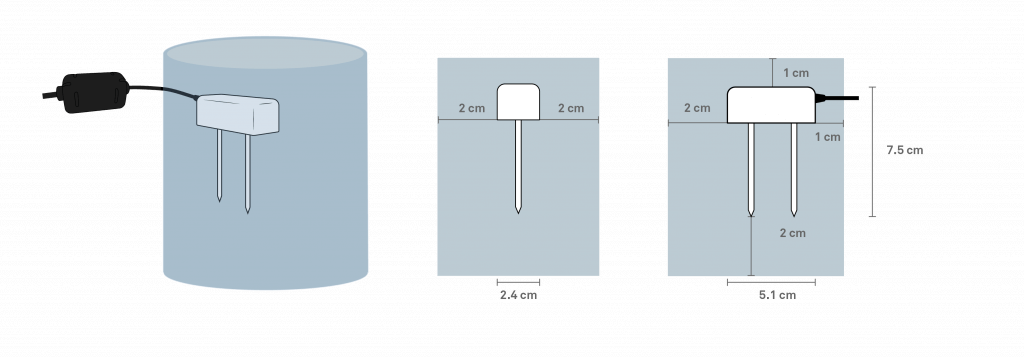
Potted Soil Moisture sensor (EC5)
This wireless soil moisture sensor is built to monitor volumetric water content (VWC) for an accurate measurement of all soils and soilless medias with a wide range of salinities. Using real-time data from soil sensors, farmers can adjust and tailor a granular approach to irrigation and nutrient delivery. Custom alerts can provide insights on which crops are in need of irrigation, and which are in need of drainage to prevent the damaging effects of overwatering including standing water compromising root development, overaccumulation of salts, root rot, fungus and mildew.
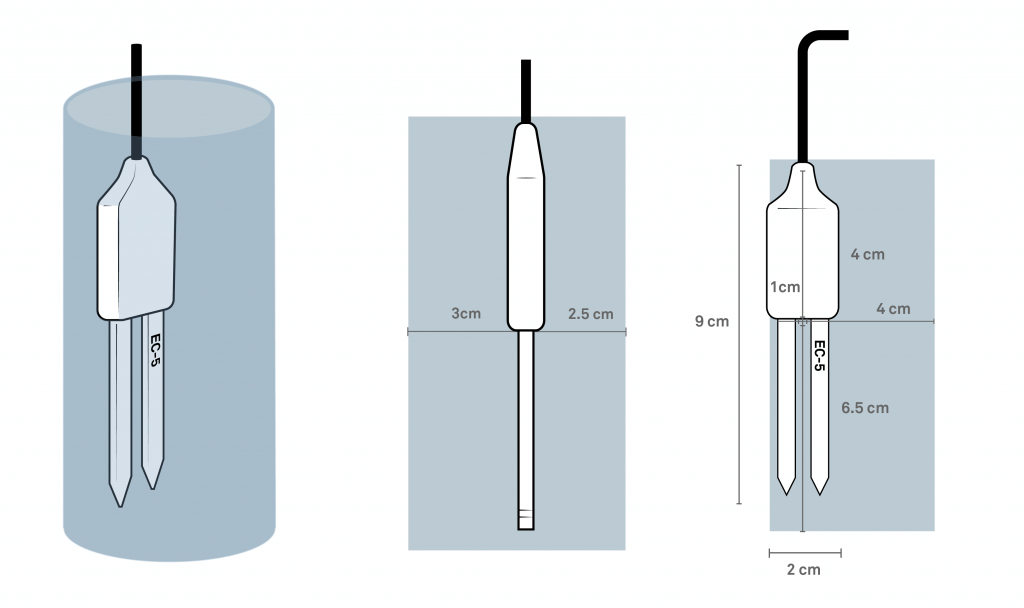
Read also: How do I install the Substrate Moisture Sensor?
Volume of influence
Every sensor has an area of the substrate where it measures its electromagnetic field. This is the volume of influence. Anything within this electromagnetic field affects the output of the sensor. The sensitivity within this electromagnetic field is not uniform, for instance, the sensor is the most sensitive a few millimetres from the probe’s needles. This has the largest influence on the measurement.
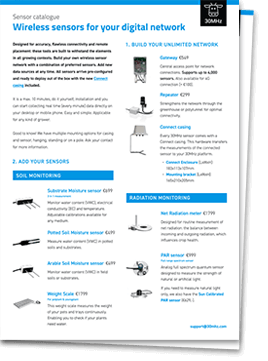 30MHz Sensor Catalogue
30MHz Sensor Catalogue
Designed for accuracy, flawless connectivity and remote placement, these tools are built to withstand the elements in all growing contexts. Build your digital infrastructure with a combination of sensors that suit your needs, and add new data sources at any time.


30MHz is typing… Our extended support team is ready to chat!
At 30MHz we think it’s important that our users can use our platform in an optimal way. At times you may have questions and you would like some help from our support team. Email and our support page filled with helpful articles were your go to’s. But we thought it was time for something extra… ...Read more
New 30MHz connect casing: How we protect your tech
To make sure your dataflow is fully protected, 30MHz introduces a new connect casing: waterproof, dust proof and even resistant to hits. This special shield will last longer and ensure a reliable dataflow from the connected sensor. What does that full protection mean? That’s what we will explain in this article. Watertight: resistant to wetness ...Read more
Summer ready?
The summer season has arrived, which means a busy time for many horticulture companies. Experienced growers rely on their instincts, but the climate challenges of the summer particularly call for good monitoring. High temperatures, plenty of light, and higher humidity are common challenges. 3 Tips for a stress-free summer: 1. Know the plant temperature throughout ...Read more

